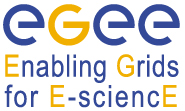Speaker
Dr
Jamie Shiers
(CERN)
Description
By the time of EGEE ‘08, the largest scientific machine in the world – the Large Hadron Collider – will not only have been cooled
down as scheduled to its operational temperature of below 2 degrees Kelvin but circulating beam should have been demonstrated.
Collisions of proton beams at 5 + 5 TeV are expected within a matter of weeks, with data taking at design energy (7 + 7 TeV)
foreseen for 2009. (http://lhc-first-beam.web.cern.ch/lhc-first-beam/Welcome.html)
In order to process the data from this world machine, we have put our “Higgs in one basket'' – that of Grid computing.
After many years of preparation, 2008 saw a final “Common Computing Readiness Challenge'' (CCRC’08) – aimed at
demonstrating full readiness for 2008 data taking, processing and analysis. By definition, this relied on a world-wide
production Grid infrastructure.
But change – as always – is on the horizon. The current funding model for Grids – which in Europe has been through 3
generations of EGEE projects, together with related projects in other parts of the world, including South America – is
evolving towards a long-term, sustainable e-infrastructure, like the European Grid Initiative (EGI). At the same time,
potentially new paradigms, such as that of “Cloud Computing'' are emerging.
This talk summarizes the results of CCRC’08 and discusses the potential impact of future Grid funding on
both regional and international application communities. It contrasts Grid and Cloud computing models from both technical
and sociological points of view. Finally, it discusses the requirements from production application communities, in terms
of stability and continuity in the medium to long term.
Primary author
Dr
Jamie Shiers
(CERN)
